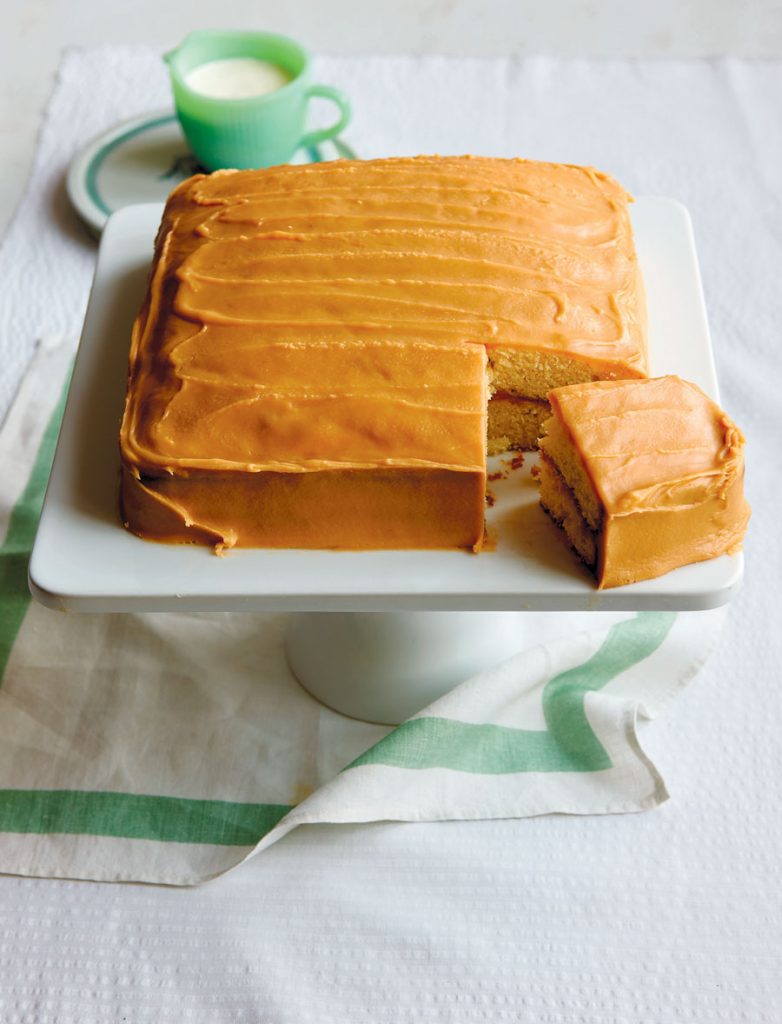This cake is excerpted from American Cake, a beautiful new book by Nashvillian Anne Byrn, (aka The Cake Mix Doctor). From Colonial Gingerbread to Classic Layer, it gives us a snapshot of the stories and recipes behind 125 of our best-loved cakes.

1. Preheat oven to 350°F. Lightly grease the bottom of two 9” round or square pans with butter and dust with flour.
2. Place the butter and sugar in a large bowl and beat with an electric mixer on medium speed until the mixture comes together and lightens, about 2 minutes. Add the eggs, one at a time, beating well after each addition. Blend in the vanilla.
3. Sift together the flour, baking powder, and salt. Alternately add the dry ingredients and the milk to the batter, beginning and ending with the dry ingredients. Blend on low speed until just incorporated. Divide the batter between the 2 prepared pans and place the pans in the oven.
4. Bake the cake until it is golden brown and the top springs back when lightly pressed with a finger, 25 to 30 minutes. Let cool 10 minutes. Flip cakes out of pan.
5. For the icing, place the butter and brown sugars in a medium-size saucepan over medium heat, and stir until the butter melts and the mixture begins to boil, 2 to 3 minutes. Add the milk, stir and let the mixture comes back to a boil.
6. Remove the pan from heat and whisk in 2½ cups of the confectioners sugar, vanilla, and salt. Whisk until smooth. If icing is too runny, add another ½ cup confectioners’ sugar. Do not add so much that the icing hardens. It will set as it cools. Assemble and frost while the icing is still spreadable. Let cake rest 30 minutes for icing to harden.
Caramel cakes have been a part of American baking for as long as cooks have put granulated sugar over heat and allowed those white crystals to melt into an amber-brown liquid. That slightly burnt flavor, the interplay of sweet and bitter, the color, the creamy consistency: These are reasons we have been forever drawn to caramel. But the caramel cake has a special place in the Mississippi Delta region. With a ready source of sugar in the cane grown in Louisiana and the New Orleans influence on the way people cooked, caramel cake became a fixture there, says Susan Puckett, Mississippi native and author of Eat Drink Delta: A Hungry Traveler’s Journey through the Soul of the South. “So many food traditions in the Delta came right up the river.” Plus, she says, caramel cakes are part of the strong entertaining culture of this region devoid of fruit trees, where people grew accustomed to making custards and layer cakes. For Delta women who loved to bake, a caramel cake took time and patience and was a badge of honor, says Puckett, “an ordeal to make, and in the Delta we celebrate those ordeals.” And while a lot of wealthy women in Mississippi have had the help of African American women in making their caramel cakes—think Minnie in The Help—the cake is still baked today by those without help, and it remains something to brag about. In recent years, Puckett says, a lot of busy Delta cooks have substituted cake mix for the scratch cake, but they still make their family’s recipe for caramel icing. Because really, this cake is all about the icing, another reason why caramel cakes have stood the test of time in the Delta. The icing is a little temperamental to prepare, and good cooks say you should never attempt it during a rainstorm or on a humid day, but once frosted, this cake can sit unaffected on a summer picnic table in the sweltering heat and humidity and not weep, not run, just sit there majestically, like some great god of Delta cooking, a shrine to the hard work that went into the cake. And a visible reminder that who needs fruit trees in the Delta when you have caramel cake?
share this: